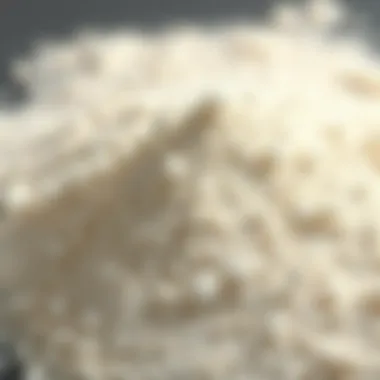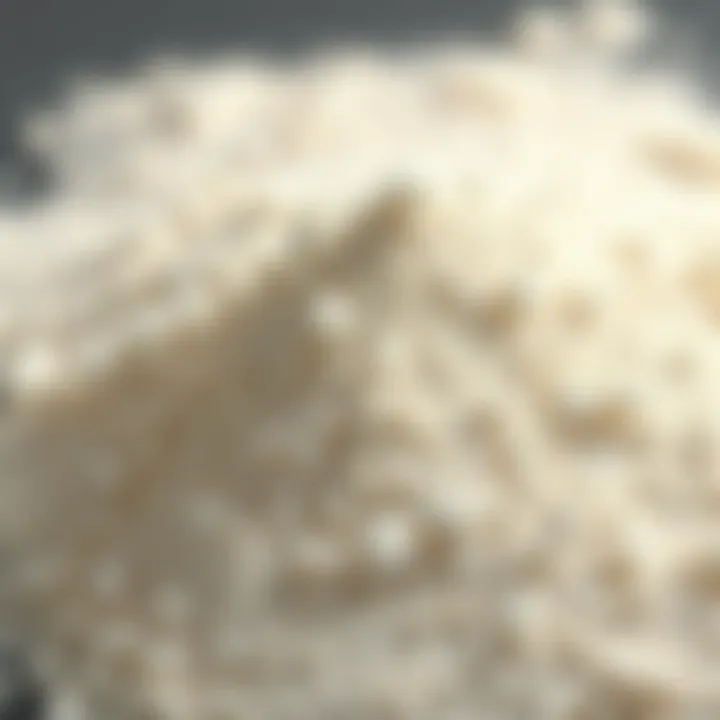Understanding Gelatin Powder: Composition and Uses


Intro
Gelatin powder, often overlooked in the pantry, deserves a closer look. This ingredient, derived from collagen found in animal bones, skin, and connective tissue, plays a pivotal role in both the culinary world and beyond. From adding texture to desserts like mousses and jellies to acting as a thickening agent in savory sauces, gelatin powder is quite versatile. But it’s not just useful; understanding its composition, uses, and benefits opens doors to innovative cooking and healthier eating.
This article peels back the layers of gelatin powder, exploring its origins, the science behind its unique properties, and various ways to incorporate it into dishes. The aim is to equip food enthusiasts with a thorough grasp of this powerful ingredient, breaking it down from the microscopic level up.
Moreover, whether you're a budding chef or a seasoned culinary artist, you'll find valuable tips on how to successfully use gelatin in your recipes. Insights into its nutritional aspects will further reshape how you perceive this unassuming powder, making it an essential ally in a balanced diet.
Stay tuned as we venture into the fascinating terrain of gelatin powder, revealing why it holds a crucial place in kitchens around the world.
Defining Gelatin Powder
Gelatin powder is a common ingredient that plays a crucial role in a variety of culinary applications. To understand its significance, it’s important to dissect its nature, origins, and uses. This section aims to unravel what gelatin powder is, linking its rich history to its modern-day applications, giving a comprehensive outlook on how it stands as a versatile component in kitchens worldwide.
What is Gelatin?
Gelatin is a translucent, flavorless food ingredient derived primarily from collagen, a protein found in animal tissues. When dried and processed, collagen turns into a powdered form known as gelatin. This powder has the unique ability to absorb water and swell, subsequently forming a gel-like consistency when cooled. This property makes it ideal for various culinary needs, including thickening liquids, stabilizing mixtures, and creating textures ranging from jellies to mousses.
The primary source of gelatin in the market comes from the skins and bones of animals such as pigs and cows. Whereas some gelatin products may be categorized as kosher or halal, indicating appropriate processing standards, the widespread belief is that gelatin can be a controversial ingredient for certain diets, particularly those steering away from animal products.
Historical Context of Gelatin Usage
The roots of gelatin usage can be traced back to ancient civilizations. Historical texts suggest that the Egyptians utilized a form of gelatin around 3000 B.C. They created a dish from boiled animal parts, recognizing its thickening properties. Meanwhile, in Europe, gelatin gained popularity during the Middle Ages. It was incorporated into elaborate feasts as decorative gelatin dishes and desserts.
Moving into the 18th century, gelatin gained traction in grand European dining halls and became a staple for high-society gatherings. Its importance surged with advancements in food preservation techniques and culinary arts. Fast forward to the early 20th century, when refined processing methods led to the modern gelatin powder we know today, truly revolutionizing both home cooking and professional culinary practices.
"Gelatin has transcended its role as a mere thickening agent, becoming a vital tool for chefs and food enthusiasts alike."
The narrated history of gelatin shows us how it transformed from a practical solution for food preparation into an essential ingredient, underpinning countless culinary creations. Understanding the basics of gelatin powder is paramount for anyone looking to explore its vast applications and benefits in both cooking and nutrition.
Composition and Source of Gelatin Powder
Understanding the composition and source of gelatin powder is crucial for grasping its multifaceted nature in kitchens and food science. Gelatin isn't merely a thickening agent; it carries a load of nutritional and culinary properties that demand attention. Knowing where it comes from and what it contains can significantly influence how it's used in recipes, from desserts to sauces. Also, as dietary preferences shift, understanding gelatin's sources—particularly in an age of plant-based movements—becomes ever more relevant.
Understanding Collagen
At its core, gelatin is derived from collagen, a protein that supports connective tissues in both animals and humans. Collagen is like the glue that holds things together, forming a substantial part of our skin, bones, and cartilage. When collagen-rich animal parts—like skin, bones, and connective tissues—are boiled down, they break apart into gelatin. This is where the magic happens; the transformation from a rigid structure into a soft, pliable ingredient that can add texture and stability to a wide range of dishes.
The process of making gelatin involves hydrolysis, where collagen is broken down into smaller peptides, making it easier to dissolve and utilize in cooking. It's notable to say that gelatin is not vegetarian, and this is essential for those who follow specific diets. The high protein content in gelatin—around 85%—adds to its appeal as a dietary supplement, although it's important to keep in mind that it lacks certain essential amino acids, making it not a complete protein.
Furthermore, the presence of glycine and proline, two amino acids prevalent in gelatin, contributes to various health benefits including better joint support and improved skin elasticity.
Sources of Gelatin: Animal vs. Plant
When discussing sources, there are two primary types of gelatin—animal and plant. Animal gelatin primarily comes from pigs and cows, but it's also derived from fish, which some find a bit more palatable. The extraction from these animals means that while gelatin is an incredible versatile ingredient, it does pose concerns for those who adhere to vegetarian or vegan diets. That said, there are alternatives emerging.
Plant-based versions, such as agar-agar, carrageenan, or pectin, offer options that mimic gelatin's gelling properties but come from seaweed, fruits, and other plant sources. In fact, both agar and carrageenan are stout contenders in the industry, offering gelatin-like textures in various culinary applications.
Here’s a quick comparison for clearer understanding:
- Animal Gelatin:
- Plant-Based Alternatives:
- Source: Mainly pork, bovine or fish.
- Uses: Commonly used in desserts, jellies, and thickening sauces.
- Texture: Provides a soft, tender feel in food preparations.
- Source: Derived from seaweed and fruits.
- Uses: Great for vegans, widely used in plant-based desserts and thickening methods.
- Texture: Can vary; agar tends to create a firmer texture than animal gelatin.
Types of Gelatin Powder


Understanding the different types of gelatin powder is crucial for anyone looking to make the most of this interesting ingredient in the kitchen. Gelatin isn't just a one-size-fits-all; it comes in several varieties, each offering distinct characteristics and applications. From culinary creations to dietary considerations, knowing which type of gelatin is the right fit can enhance both flavor and texture in your dishes.
Common Types of Gelatin
When discussing the common types of gelatin, there are a few that stand out due to their popularity and versatility.
- Powdered Gelatin: Often the most recognized form, powdered gelatin is commonly used in a variety of recipes. It is easy to find in grocery stores and is preferred by many home cooks due to its straightforward application. The process involves blooming the gelatin in cold water before adding it to warm mixtures, allowing it to dissolve completely.
- Sheet Gelatin: Also known as leaf gelatin, this form is preferred by professional chefs and can produce a smoother finish in certain dishes. Each sheet needs to be soaked in cold water until pliable, then squeezed to remove excess moisture before being added to your mixture. This method tends to yield better results in delicate preparations like mousses or panna cottas.
- Agar-Agar: Although not a traditional gelatin, agar-agar is a plant-based gelling agent derived from red algae. It's gained traction as a substitute for those seeking vegetarian or vegan options. Agar sets at a higher temperature and requires more precision in measurements, making it slightly less forgiving than its animal-derived counterparts.
Key Point: Choosing the right type of gelatin can significantly affect the texture, clarity, and overall success of your dish. It’s worth experimenting to find what works best for your culinary needs.
Vegetarian and Vegan Alternatives
With the growing demand for plant-based options, there has been a rise in alternatives to traditional gelatin. For those who avoid animal products, suitable substitutes are essential.
- Agar-Agar: As mentioned earlier, it’s a prime alternative. It’s suitable for a wide range of desserts and jellies, and because it firms up much more than gelatin, it’s great for making vegan gummy candies or even thick sauces.
- Carrageenan: Another seaweed-derived product, carrageenan is often used in dairy alternatives like plant-based milks and yogurts to improve texture. It can create a similar mouthfeel as gelatin but tends to have a unique flavor profile that may not suit every recipe.
- Kudzu Starch: Less common but worth mentioning, kudzu starch can be used as a gelling agent and thicken sauces. It's a great option for cooks looking for a versatile ingredient that thickens without altering the flavor significantly.
- Pectin: Commonly found in fruit preserves, pectin is a carbohydrate found in the cell walls of fruits. It’s excellent for making jellies and jams but requires sugar to activate.
Incorporating these alternatives into your cooking can open up a world of textures and flavors while adhering to dietary choices. Experimentation here can lead to delightful surprises!
Culinary Applications of Gelatin Powder
Gelatin powder plays a significant role in the culinary world, serving as a multifunctional ingredient that melding tradition with innovation. This section dives into how gelatin transforms both home-cooked meals and fine dining dishes, highlighting its vital functions and versatile applications in food preparation.
Thickening and Gelling Agent
One of the prime uses of gelatin is as a thickening and gelling agent. When dissolved in hot water and then cooled, gelatin sets into a firm structure, which can be used to create a variety of dishes like puddings, jellies, and terrines. Imagine the delight of pulling a perfectly wobbly panna cotta from its mold, gleaming with a glossy finish. The art of gelling doesn’t just end with desserts; it extends to savory dishes as well, such as aspics or meat jellies, which often surprise our tastebuds with their depth and complexity.
The ability to form a gel can transform liquids into a delightful texture, enhancing the mouthfeel and overall experience of a dish. However, it is important to pay attention to the concentration of gelatin used—too little and the result may collapse, too much and the dish can become overly firm. Thus, understanding the delicate balance is key.
Stabilization in Food Products
In addition to gelling, gelatin contributes significantly to the stabilization of emulsions and foams in food products. It works wonders in creams and mousses, maintaining their fluffy texture while simultaneously preventing separation. A notable example is in whipped toppings and marshmallow fluff, where gelatin ensures the consistency remains just right, making it a crucial player in baking and dessert-making.
Furthermore, in commercial food production, gelatin is a common ingredient in cosmetic formulations and refrigerated products, such as yogurts and salad dressings. The stabilizing properties it provides allow these products to maintain their intended textures and flavors longer during storage. By doing this, gelatin not only enhances the quality of food but also supports shelf stability—an essential requirement in various food industries.
Infusing Flavor in Culinary Creations
Gelatin is often overlooked when it comes to enhancing flavors, yet it plays an important role. In dishes like jellies or savory stocks, gelatin captures the essence of various ingredients, allowing them to integrate and meld together. It acts as a canvas for flavors, allowing chefs to experiment with different combinations and presentations.
For instance, in a fruit or herb jelly, the infusion of flavors becomes an integral part of the dish. This not only adds complexity but invites a sensory exploration—what begins as a simple liquid can give way to a layered experience in taste, triggering memories associated with those flavors.
Moreover, in innovative culinary trends, like cocktail gels or flavored foams, gelatin unquestionably opens new frontiers. Chefs can take classical flavors and offer them in unexpected forms, resulting in dishes that intrigue and surprise.
"In the hands of a skilled chef, gelatin is not just a thickening agent; it is a sophisticated tool for artistic expression, blending texture, flavor, and stability into harmonious dishes."
As can be seen, gelatin's culinary applications are vast and essential. Whether used to thicken sauces, stabilize mixtures, or infuse dishes with rich flavors, it remains a staple in kitchens around the world. Understanding how to harness gelatin's properties not only enriches the cooking experience but also elevates the food served on the plate.
Nutritional Profile of Gelatin Powder
The nutritional profile of gelatin powder plays a noteworthy role in understanding its significance within both culinary and health-related contexts. Packed with essential nutrients, gelatin is a protein-rich substance derived from collagen. Understanding its nutritional aspects can shed light on its widespread usage in various recipes and dietary considerations.
Protein Content and Amino Acids
Most importantly, gelatin powder is predominantly composed of protein. Surprisingly, it contains about 85-90% protein by weight, making it one of the richest sources of dietary protein available. Unlike complete proteins found in animal products such as meat and dairy, gelatin is classified as a partial protein. It lacks certain essential amino acids, but it is packed with an abundance of specific amino acids that serve a variety of functions in our bodies.
Among these amino acids, glycine and proline stand out. Glycine, in particular, plays a vital role in the synthesis of several key biological compounds and is known for its contribution in improving sleep quality and reducing anxiety. Proline, on the other hand, supports collagen formation, which is essential for skin and joint health. While gelatin isn’t a substitute for full proteins, it can complement diets in unique ways, providing particular benefits through its specialized amino acid composition.
The specific profile of gelatin's amino acids can be summarized as such:
- Glycine: Important for muscle repair and digestive health.
- Proline: Aids in collagen and tissue structure.
- Alanine: Supports energy production and immune function.


Incorporating gelatin powder into the diet allows individuals to harness the benefits of these amino acids, but it's critical to remember it should be paired with other protein sources to ensure a balanced intake of essential nutrients.
Gelatin's Role in Diets
Gelatin's role in diets goes beyond just its protein content; it can be integral to various dietary strategies. Many health-conscious individuals are seeking alternatives that enhance their wellbeing, and gelatin fits the bill in several popular dietary trends. Some of these include:
- Low-Carb Diets: Given its carbohydrate-free nature, gelatin is an excellent addition for those on ketogenic or low-carb diets. It can help satisfy cravings for desserts and sweets without spiking blood sugar levels.
- Paleo Diet: As a natural product sourced from animals, gelatin aligns perfectly with the principles of the paleo diet, emphasizing whole foods and natural ingredients.
- Gut Health: There’s an emerging body of research suggesting that gelatin can help maintain the integrity of the gut lining, promoting digestive health. Many proponents recommend it for those dealing with gut permeability issues, also known as leaky gut syndrome.
Additionally, incorporating gelatin powder into smoothies, soups, and sauces can enhance the overall nutrient density of meals while providing a unique texture.
"Gelatin helps to bridge the gap between culinary delights and health benefits, making it a fascinating ingredient worth exploring for any food lover looking to elevate their meals."
In summary, the nutritional profile of gelatin powder displays not only its rich protein content but also highlights its unique amino acids. Understanding its role in various diets opens up a realm of possibilities for health enthusiasts and culinary masters alike. With the growing interest in health benefits associated with gelatin, its usage will likely continue to evolve and inspire creative applications in recipes.
Health Benefits and Risks of Gelatin Powder
Gelatin powder isn't just a kitchen staple; it carries potential health benefits that can surprise many. However, with these benefits come certain considerations worth discussing. Understanding both sides is essential for anyone thinking of incorporating gelatin into their diet. Whether you’re a culinary explorer or just trying to improve your health, it’s important to comprehend why this ingredient is so widely used yet often overlooked.
Potential Health Benefits
Gelatin has found its way into health conversations quite often, and for good reason. Here are several benefits that have caught the attention of nutritionists and food lovers alike:
- Rich in Amino Acids: Gelatin is packed with proteins that contain important amino acids such as glycine and proline. These contribute to maintaining healthy joints and skin, almost like a natural booster for our connective tissues.
- Digestive Aid: Consuming gelatin may improve gut health by making the stomach lining more robust. It can help digest certain foods, especially proteins, facilitating better nutrient absorption and reducing feelings of bloating.
- Bone and Joint Health: Regular consumption could promote joint function and bone health. Some studies suggest that gelatin may aid in the management of conditions like arthritis due to its collagen-like properties, which can help maintain cartilage integrity.
- Skin Elasticity: There's talk about gelatin promoting healthier skin by improving elasticity. Those looking to maintain a youthful complexion might find their skin reaping the benefits of this protein-rich addition to their diet.
- Weight Management: Gelatin may help with satiety, keeping hunger pangs at bay. Including it in meals could possibly help manage calorie intake, a plus for anyone aiming to maintain a healthy weight.
"Gelatin can be a powerhouse in the kitchen, and the health benefits it offers may surprise those looking for a nutritious edge in their meals."
While the benefits are compelling, one should keep in mind that moderation is necessary. Incorporating gelatin into a balanced diet is key to reaping these advantages without the common pitfalls of overconsumption.
Possible Allergies and Intolerances
It’s crucial to understand that gelatin isn't for everyone. Some individuals may experience allergies or intolerances that can lead to adverse reactions. Here are a few considerations:
- Animal Sourcing: Most gelatin comes from animal products, primarily from pigs and cows. This makes it unsuitable for vegetarians, vegans, or individuals with certain dietary restrictions. Always check sources and be mindful of other dietary needs.
- Allergic Reactions: Although rare, some people can have allergies to the proteins found in gelatin. Symptoms include itching, swelling, or gastrointestinal disturbances. If any of these symptoms appear after consuming products with gelatin, consult a healthcare provider immediately.
- Cross-Contamination: For those with severe food allergies, it's important to be aware of the possibility of cross-contamination during processing, making it essential to choose brands that prioritize safety and transparency.
- Interaction with Medications: Some medications may interact with the properties of gelatin, possibly affecting their efficacy. As always, consulting with a health professional before making changes to your diet is prudent.
In a world where dietary choices are increasingly diverse, it's essential for individuals to weigh the benefits against personal health considerations when thinking about incorporating gelatin powder into their meal plans. It’s always smart to stay informed, and tuning into your body can lead to better, healthier choices in the long run.
Incorporating Gelatin Powder into Recipes
Gelatin powder can be a transformative ingredient in the kitchen, turning simple dishes into culinary masterpieces. Its unique properties lend themselves beautifully to thickening, stabilizing, and gelling, making it a staple for both beginner cooks and seasoned chefs. Understanding how to incorporate gelatin powder effectively is essential. It allows for the creation of a variety of textures and presentations in food, enriching the dining experience while adding nutritional value. Popular among food enthusiasts, gelatin enhances various recipes, yet leveraging it correctly requires some knowledge of technicalities.
Basic Techniques for Using Gelatin
Using gelatin might seem daunting for first-timers, but with some straightforward techniques, it becomes easy as pie. The success of using this ingredient often relies on the proper handling. Here’s how to get started:
- Blooming Gelatin: This is the first and crucial step. Gelatin needs to be softened in cold water—typically, this means sprinkling it over water, allowing it to hydrate for a few minutes until it swells. This process is often described as getting gelatin to "bloom."
- Dissolving Gelatin: Once bloomed, heat it gently to dissolve. Ensure not to boil it, as high heat can damage the gelling properties.
- Incorporating into Mixtures: After dissolving, it's important to temper the gelatin by adding a small amount of the warm mixture to it before combining everything together. This prevents clumping and ensures a smooth texture in the final product.
- Chilling and Setting: After mixing with your main ingredients, allow the dish to cool in the fridge. The hardening process may take several hours, so patience is key.
These techniques are foundational for many recipes and can make a world of difference in the final outcome.
Creative Recipe Ideas
Incorporating gelatin into recipes can open the door to many delicious possibilities. Here are a few creative ideas that highlight what gelatin can do:
- Fruit Jellies: Combine fruit puree with sugar and gelatin for a refreshing dessert. Using seasonal fruits can elevate the taste while showcasing colors.
- Savory Aspics: For an interesting appetizer, create a savory gelatin using stock, diced vegetables, and herbs. This can serve as a unique starter at a dinner party, previously an often overlooked culinary gem.
- Marshmallows: Homemade marshmallows are an adventurous endeavor. By mixing gelatin with sugar syrup and flavorings, you get a fluffy treat perfect for topping hot cocoa.
- Gelatin Shots: Offering a playful twist, these adult-friendly treats can be flavored with various liquors to make them a fun addition to parties.
"Gelatin serves as a bridge between creativity and science in cooking. With proper techniques, it allows chefs to manipulate texture and presentation, elevating the dining experience to unforeseen heights."
In summary, any cook can find ways to use gelatin. With the basic techniques mastered and a handful of creative ideas at one's fingertips, you'll be on your way to impressing guests and family alike with stunning, textural dishes.
Understanding Gelatin in Modern Cuisine


In today’s culinary world, gelatin powder stands as a versatile and essential ingredient, steering many trends in cooking and dessert making. Its unique ability to transform both texture and flavor profiles in various dishes has made it a go-to for chefs and cooking enthusiasts alike. Delving into the modern practices of gelatin, we come across not just its common uses but also the evolving way it’s perceived and integrated into kitchens around the globe. As our understanding deepens, recognizing its significance becomes more crucial.
Trends in Gelatin Use
The current trends surrounding gelatin illustrate both innovation and a return to traditional techniques. In upscale restaurants, you might notice a surge in the use of gelatin for creating intricate plated desserts, where the aesthetics of a dish can rival its taste. The resurgence of classic techniques, like aspic and terrines, exemplifies how chefs are remixing old practices to cater to contemporary palettes.
Home cooks are also feasting on the trend, utilizing gelatin in savory dishes such as foams and sauces, pushing boundaries far beyond mere desserts. Social media platforms are ablaze with images of gelatin inclusion, engaging foodies to replicate visually stunning dishes.
Furthermore, health-focused cooking has catalyzed the exploration of gelatin's adaptability. Dietary adjustments have encouraged the embrace of gelatin not only for its thickening properties but to fortify dishes with additional nutrients, especially in gluten-free cuisines. Gelatin gets a spotlight here, as it naturally adds texture without compromising dietary needs, which is riding the wave of health consciousness among cooks and diners alike.
"The evolution of gelatin in modern cuisine reflects a journey of transformation, merging tradition with innovative culinary practices."
The Rise of Gelatin-Based Desserts
As culinary landscapes continue to evolve, gelatin-based desserts have taken center stage, captivating dessert lovers everywhere. The allure of these creations often lies in their textural contrast—smooth, creamy custards paired with jellied components that create an interesting mouthfeel. This duality indulges the senses and keeps diners coming back for more.
Popular desserts showcasing gelatin include panna cotta, marshmallows, and mousse. Each of these treats showcases gelatin’s unique talents, from achieving a melt-in-your-mouth sensation to crafting airy layers that please both the eye and the taste buds. Moreover, the rise of these desserts has sparked the creativity of home bakers who are venturing into making their own fruit gels or jelly shots, appealing to a wide audience.
Additionally, plant-based alternatives to gelatin are popping up, catering to vegan and vegetarian diets; these diverse options are pushing the envelope further, leading to inventive dessert forms that still carry the charm associated with gelatin desserts. The interplay of flavors and textures beckons an exciting exploration in the kitchen, inviting everyone to experiment and discover their own unique takes on gelatin treats.
Sustainability and Ethical Considerations
As the culinary world increasingly embraces sustainability, the topic of gelatin powder's sourcing and its impact on the environment comes under scrutiny. In a time when health-conscious and environmentally-aware consumers are making their voices heard, understanding the ethical implications of gelatin production has become paramount. This section dives into these considerations, highlighting the importance of conscious consumption regarding gelatin and its challenges.
Sourcing Ethical Gelatin
When speaking about ethical gelatin, it’s essential to understand where it comes from. Traditionally, gelatin is derived from animal products, predominantly from pork and cattle sources. However, in light of rising moral concerns regarding animal welfare and factory farming practices, some companies are pivoting towards sourcing gelatin from more responsible and sustainable producers.
- Look for brands that are transparent about their sourcing practices. Many have embraced a farm-to-table approach, ensuring animals are raised in humane conditions.
- Certifications can be a game-changer. Opting for gelatin that carries humane or organic certifications can add a layer of assurance.
- There’s also a growing market for vegetarian or vegan alternatives, such as agar-agar, derived from seaweed, or pectin from fruits. These options provide a way for consumers to avoid animal products entirely while still achieving similar culinary results.
What you choose to buy impacts not just your cooking but also the broader landscape of food production. Every purchase acts like a vote for the kind of systems you want to support. If you value sustainability, it’s worth looking into brands that prioritize ethical sourcing practices.
Environmental Impact of Gelatin Production
The production of gelatin is not without its environmental challenges. Here’s what’s at stake:
- Land Use: Gelatin production requires significant land resources for livestock. This contributes to deforestation, especially in regions where forests are cleared for pasture.
- Water Footprint: Raising livestock consumes massive amounts of water, not just for the animals themselves but also for the crops used to feed them.
- Greenhouse Gas Emissions: The livestock industry is a known contributor to greenhouse gases. The production of gelatin, therefore, carries an environmental weight that cannot be ignored.
Despite these issues, industry innovations are underway. Some companies are marching towards more sustainable practices, such as using by-products from the meat industry that would otherwise go to waste. This doesn’t just reduce unnecessary slaughter; it minimizes waste and promotes resourceful use of materials.
"Supporting sustainable gelatin sources can help reduce the overall environmental impact of food production and promote ethical treatment of animals."
In summary, the effects of gelatin production on the environment and animal welfare form a critical part of the broader conversation about food sustainability. By being informed about where and how gelatin is produced, consumers can contribute to a more sustainable food system. This awareness is not just beneficial for the planet but also encourages a more conscientious approach to culinary practices.
Ultimately, as we engage with this versatile ingredient, it's important to strike a balance between enjoying its culinary benefits while ensuring it aligns with our values on sustainability and ethics.
Culmination
In wrapping up our comprehensive discussion on gelatin powder, it becomes evident that this versatile ingredient holds a notable place in both culinary and health contexts. The importance of gelatin powder extends beyond mere kitchen applications; it acts as a bridge connecting tradition with innovation in food preparation. From its historical roots to its sophisticated presence in contemporary cooking, gelatin powder demonstrates remarkable adaptability.
Summarizing Gelatin Powder's Importance
At its core, gelatin powder is essential for achieving specific textures and consistencies in various dishes. It serves as a significant thickening and gelling agent, making it indispensable in many culinary applications. By understanding its composition and properties, cooks can unlock a world of possibilities in the kitchen.
- Texture and Consistency: Gelatin provides a unique mouthfeel in desserts such as mousses and panna cottas, elevating the dining experience.
- Nutritional Value: With its rich protein content, gelatin contributes to a balanced diet, offering amino acids that support health and wellness.
- Wide Applications: Beyond desserts, gelatin is a key player in savory dishes, providing structure, stability, and even enhancing flavors in sauces and soups.
In essence, gelatin powder is not just an ingredient; it's a pivotal element that supports culinary creativity. Its influence ripples through various cuisines, demonstrating why many chefs and home cooks alike regard it as a fundamental staple.
The Future of Gelatin in Culinary Practices
Looking ahead, the trajectory of gelatin in the culinary world appears promising. As food trends evolve, so too does the way we think about this ingredient. Its adaptability to modern cooking techniques and the growing interest in plant-based alternatives signal a shift in utilization.
- Innovative Cooking Techniques: The rise of molecular gastronomy has explored gelatin in ways that challenge conventional methods, creating unique dining experiences. This reflects the increased acceptance of science in the culinary arts.
- Ethical Considerations: As awareness grows about sourcing and sustainability, the demand for ethically produced gelatin will likely encourage producers to adopt better practices, ensuring a more responsible supply chain.
- Plant-Based Alternatives: The emergence of vegan substitutes for gelatin, such as agar-agar and pectin, offers exciting prospects for inclusivity in recipes and cuisines across dietary preferences.
In summary, gelatin powder stands as a testament to the intersection of culinary tradition and innovation. As we continue to explore new horizons in cooking, gelatin's role will adapt and transform, ensuring its presence in kitchens around the world for generations to come. The heart of gastronomy beats strong with gelatin, echoing the importance of understanding and utilizing this remarkable ingredient.















